Saudi-Arabien |
|
|
|
| Übersicht – Contents: | |
Saudi-Arabien |
|
|
|
| Übersicht – Contents: | |
Erklärung – Explanation: |
|
| Ein besonderes Merkmal der Flaggen auf dieser Webseite ist eine Inschrift mit arabischer Schrift. Im europäischen Verständnis wird jede Inschrift auf einer Flagge auf der Vorderseite der Flagge betrachtet, die Schrift immer von links nach rechts laufend, so dass die jeweilige Inschrift neben dem links stehenden Mast beginnt und nach rechts – in Richtung wehendes Ende der Flagge – weiterläuft. Die arabische Schrift wird aber von rechts nach links gelesen. Die europäische Betrachtungsweise sollte nicht auf Flaggen mit arabischen Inschriften übertragen werden, denn wäre der Mast links, würde die arabische Schrift vom wehenden Ende zum Mast hin laufen, was nicht sein darf. Manchmal wird dieses Argument noch von Abbildungen verstärkt, z.B. ein Schwert, dessen Schwertspitze in Richtung Ende der Schahada zeigt. Will man das auf dieser Art Flaggen richtig zeigen, muss die Schrift vom Mast weglaufen, arabisch von rechts nach links, das Schwert dann ebenfalls von rechts nach links zeigen, wodurch der Mast zwingend rechts stehen muss. Um diese Art Flaggen richtig zu verwenden, müssen zwei Vorderseiten gegeneinander genäht werden, ein spiegelverkehrter Durchdruck wäre nicht anbracht. |
A special feature of the flags on this website is an inscription with Arabic
script. In European understanding, any inscription on a flag is considered
to be on the front of the flag, the writing always running from left to
right, so that the respective inscription starts next to the pole on the
left and continues to the right - towards the waving end of the flag. The Arabic script, however, is read from right to left. The European way of understanding at these things should not be applied to flags with Arabic inscriptions, because if the pole were on the left, the Arabic writing would run from the waving end towards the pole, which is not allowed. Sometimes this argument is reinforced by illustrations, e.g. a sword with the tip of the sword pointing towards the end of the shahada. If one wants to show this correctly on this type of flag, the writing must run away from the mast, Arabic from right to left, the sword then also pointing from right to left, which means that the mast must necessarily be on the right. In order to use this type of flag correctly, two front sides must be sewn against each other, a mirror-inverted print-through would not be appropriate. |
Flaggen – Flags: |
|
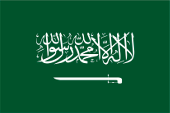  |
Nationalflagge – national flag, Seitenverhältnis – ratio = 2:3, Quelle/Source, nach/by: Flags of the World   |
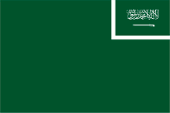  |
Handelsflagge – merchant flag, Seitenverhältnis – ratio = 2:3, Quelle/Source, nach/by: Flags of the World |
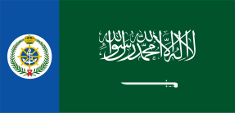  |
Marineflagge – naval flag, Seitenverhältnis – ratio = 12:25, Quelle/Source, nach/by: Flags of the World, Wikipedia (EN) |
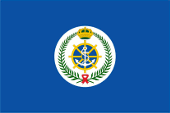 |
Gösch – naval jack, Seitenverhältnis – ratio = 2:3, Quelle/Source, nach/by: Flags of the World, Wikipedia (EN) |
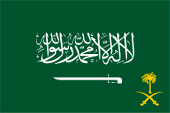  |
Flagge des Königs – flag of the King, Seitenverhältnis – ratio = 2:3, Quelle/Source, nach/by: Flags of the World, Wikipedia (EN) |
 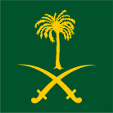 |
Standarte des Königs – standard of the King, Seitenverhältnis – ratio = 1:1, Quelle/Source, nach/by: Wikipedia (EN) |
historische Flaggen – historical Flags: |
|
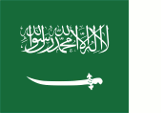  |
1932–1934, Variante – variant, Nationalflagge – national flag, Quelle/Source, nach/by: Wikipedia (AR), Orange Tuesday, Public domain, via Wikimedia Commons |
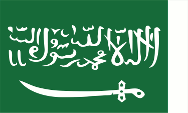  |
1932–1938, Variante – variant, Nationalflagge – national flag, Quelle/Source, nach/by: Flags of the World |
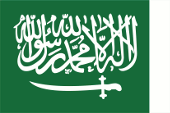  |
1932–1938, Variante – variant, Nationalflagge – national flag, Quelle/Source, nach/by: Flags of the World |
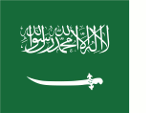  |
1934–1938, Variante – variant, Nationalflagge – national flag, Quelle/Source, nach/by: Wikipedia (AR), Orange Tuesday, Public domain, via Wikimedia Commons |
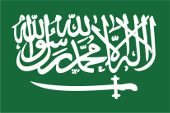  |
1938–1973, Nationalflagge – national flag, Seitenverhältnis – ratio = 2:3, Quelle/Source, nach/by: Flags of the World, World Statesmen |
 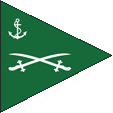 |
1938–1946(?), Handelsflagge(?) – merchant flag(?), Quelle/Source, nach/by: Flaggen und Wappen |
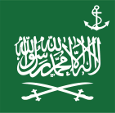  |
1938–1946(?), Marineflagge(?) – naval flag(?), Quelle/Source, nach/by: Flaggen und Wappen |
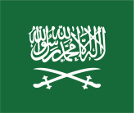  |
1938–1953, Standarte des Königs – standard of the King, Quelle/Source, nach/by: Flaggen und Wappen, Wikipedia (EN) |
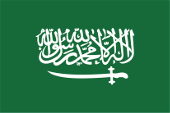  |
1973–1981, Nationalflagge – national flag, Seitenverhältnis – ratio = 2:3, Quelle/Source, nach/by: Flags of the World |
| Die Flagge von Saudi-Arabien ist einfarbig dunkelgrün und zeigt auf einem Achtel der Gesamtfläche der Flagge die Schahada, das Bekenntniswort des Islam ("Allah il Allah, wa Muhammad rasul Allah" → "Es gibt keinen Gott ausgenommen den Gott; Mohammed ist Allahs Gesandter"), darunter ergänzt um ein weißes, waagerechtes Schwert, dessen Schwertspitze in Richtung Ende der Schahada zeigt. Vorder- und Rückseite der Flagge müssen von beiden Seiten normal lesbar sein. In ihrer heutigen Ausführung der Flagge Saudi-Arabiens wurde offiziell am 15.03.1973 eingeführt, wobei erstmals genaue Bestimmungen zum Design festgelegt wurden. Die Farbe Grün ist als Pantone 2427 C definiert. Offenbar wurde Flagge (die Quellen sind nicht eindeutig) im Jahre 1981 ein wenig verändert. Die Form des Schwertes wurde von einem Krummsäbel zu einem geraden Schwert mit einem einfachen Heft abgeändert und auch im Schriftbild gab es anscheinend kleine Veränderungen, das bis heute in abweichenden Formen zu finden ist. |
The flag of Saudi Arabia
is a solid dark green coloured bunting and displays the shahada, the creed
of Islam ("Allah il Allah, wa Muhammad rasul Allah" → "There is no God
except the God; Muhammad is Allah's messenger") on one eighth of the total
area of the flag, supplemented below by a white horizontal sword, with the
tip of the sword pointing towards the end of the shahada. The front and back of the flag must be normally legible from both sides. In its current design, the flag of Saudi Arabia was officially introduced on 15th of March in 1973, the first time precise design provisions were established. The colour green is defined as Pantone 2427 C. Apparently the flag was changed a little in 1981 (sources are not clear). The shape of the sword was changed from a scimitar to a straight sword with a simple hilt and there were apparently also small changes in the typeface, which can still be found in different forms today. |
| Zwischen 1938 und 1973 zeigten einige Flaggen Saudi-Arabiens zwei gekreuzte Schwerter, ab 1946 nur auf königlichen Flaggen. Die Flagge der Sauds hatte in Nedschd und in Saudi-Arabien bis 1938 einen schmalen weißen Streifen am Liek. Die Schahada füllte bis 1973 die Flagge flächig. Danach wurde festgelegt, dass sie nur noch ein Achtel der Fläche des Flaggentuchs bedeckt. Die Flagge Saudi-Arabiens genießt auf Grund der hochverehrten Schahada besonderes Ansehen, die darf niemals auf Halbmast gesetzt und nicht vertikal angeordnet werden. Selbst das Tragen in der Hand, falten, Drucken auf Verpackungen (die dann weggeworfen werden) ist als schwierig anzusehen. In jüngster Zeit gab es Überlegungen eine zusätzliche Nationalflagge zu schaffen, die anders gestaltet sein soll, so dass mit ihr z.b. bei Sportveranstaltungen einfacher umgegangen werden kann. |
Between 1938 and 1973,
some flags of Saudi Arabia showed two crossed swords, from 1946 on royal
flags only. The Sauds' flag had a narrow white stripe on the mast-side in Nedjd
and in Saudi Arabia to 1938. The Shahada filled the flag until 1973. After that, it was stipulated that it would only cover one-eighth of the flag's cloth. The flag of Saudi Arabia enjoys special prestige because of the revered Shahada, which may never be set at half-mast and may not be arranged vertically. Even carrying it in the hand, folding it, printing it on packages (which are then thrown away) is considered problematic. Recently, there have been considerations to create an additional national flag, which should be designed differently so that it can be handled more easily, e.g. at sporting events. |
| Die Farbe Grün war die Farbe des Mantels des Propheten Mohammed. Seinerzeit war es (auch in Europa) manchmal üblich Kleidungsstücke als Flagge zu verwenden. So auch beim Mantel von Mohammed. Die Farbe des Mantels wurde so sehr schnell zu Farbe und Flagge des Islam, und speziell zur Farbe der Fatimiden, einer ismailitisch-schiitischen Kalifendynastie, die auf den vierten Kalifen Ali, und Fatima, die Tochter Mohammeds zurückgeht. | The colour green was the colour of the Prophet Mohammed's coat. At that time, it was sometimes customary (also in Europe) to use items of clothing as flags. This was also the case with Mohammed's coat. The colour of the mantle thus very quickly became the colour and flag of Islam, and specifically the colour of the Fatimids, an Ismaili Shiite dynasty of caliphs dating back to the fourth caliph Ali, and Fatima, the daughter of Mohammed. |
| Im 18. Jahrhundert gründete Ibn Abd al-Wahhab (1720–1792) eine islamisch-sunnitische Bewegung, die später nach ihm benannt wurde, die Wahhabiten. Er missionierte in Nedschd, und gewann ab 1745 großen Einfluss auf die Familie Saud, die Herrscher des Emirats Al-Darija. Diese Familie übernahm vollständig die Symbolik der Wahabiten (die Farbe Grün, die Schahada), so dass diese Symbolik im 20. Jahrhundert zur Heraldik des Königreichs Nedschd und später auch des Königreichs Saudi-Arabien wurde. Das Schwert wurde 1906, nach anderen Quellen bereits 1902, in die Flagge des damaligen Saudi-Emirates Nedschd aufgenommen und bezieht sich auf den Staatsgründer von Saudi-Arabien Ibn Saud Abdul-Asis (1880–1953). Es versinnbildlicht die militärischen Triumphe des Islam, der Familie Saud und der Wahabiten. Es steht für Gerechtigkeit und Rechtschaffenheit. |
In the 18th century, Ibn
Abd al-Wahhab (1720–1792) founded an Islamic Sunni movement later named
after him, the Wahhabis. He proselytised in Nedshd, and from 1745 gained
great influence over the Saud family, the rulers of the Emirate of
Al-Darija. This family completely adopted the symbolism of the Wahabis (the
colour green, the Shahada), so that this symbolism became the heraldry of
the Kingdom of Nedshd in the 20th century, and later also of the Kingdom of
Saudi Arabia. The sword was added to the flag of the then Saudi emirate of Nedjd in 1906, according to other sources as early as 1902, and refers to the founder of the state of Saudi Arabia Ibn Saud Abdul-Asis (1880-1953). It symbolises the military triumphs of Islam, the Saud family and the Wahabis. It stands for justice and righteousness. |
| Quelle/Source: Wikipedia (AR), Wikipedia (EN), Flaggen und Wappen der Welt, Die Welt der Flaggen | |
Wappen – Coat of Arms: |
|
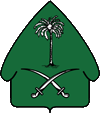 |
Wappen von Saudi-Arabien – coat of arms of Saudi Arabia Quelle/Source, nach/by: Flaggen und Wappen |
| Das Staatswappen zeigt in einem grünen Schild, vermutlich ein Zelt, zwei weiße gekreuzte Schwerter und darüber eine weiße Dattelpalme. Die gekreuzten Schwerter symbolisieren die Vereinigung der beiden Landesteile Nedschd und Hedschas, sowie Entschlossenheit den Islam zu verteidigen. Die Palme steht für Geduld und Ausdauer, repräsentiert die Landwirtschaft des Landes und ist das Symbol der Oase in der Wüste. Das Wappen wurde zwar erst 1950 eingeführt, jedoch galten Palme und Säbel etwa seit 1930 als die Hoheitszeichen von Saudi-Arabien. Das Schild wird in der Praxis häufig weggelassen. So gibt es schwarz-weiße und grün-weiße Darstellungen von Palme und Schwertern, die als Wappen verwendet werden. | The coat
of arms shows within a green shield – probably a tent – two white crossed
swords and above that a white date palm tree. The crossed swords symbolize
the unification of the boths landscapes Nadjd and Hedjas, as well as the
determination to defend the Islam. The palm tree stands for patience and perseverance, represents the agriculture of the country and is the symbol for the oasis in the desert. The coat of arms was indeed introduced not until 1950 but counted palm tree and saber since ca. 1930 for the national emblem of Saudi Arabia. The shield is in practice frequently leaved out. There exist black-white and green-white portrayals of palm tree and swords and they are used as coat of arms. |
| Quelle/Source: Flaggen Wappen Hymnen, Flaggen und Wappen der Welt, Volker Preuß | |
Flugzeugkokarde – aircraft roundel: |
|
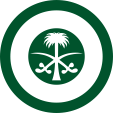 |
Flugzeugkokarde – aircraft roundel Quelle/Source, nach/by: Wikipedia (EN) |
| Landkarte – Map: |
Lage – Position: |
Landkarte des Landes – Map of the Country: |
| Die Arabische Halbinsel – The Arabian Peninsula: |
| interaktive Landkarten – clickable Maps: |
|
|
|
|
| Zahlen und Fakten – Numbers and Facts: | |
|
|
|
|
|
|
|
|
|
|
|
|
|
|
|
|
|
|
|
18.09.1932 · Gründung des Königreichs Saudi-Arabien unter König Ibn Saud
Abdul-Asis III. durch Vereinigung des Königreichs Hedschas mit dem
Königreichs Nedschd 1932 · Krieg zwischen Saudi-Arabien und Jemen 20.05.1934 · Friede von Taif zwischen Saudi-Arabien, Jemen, Italien und Großbritannien 1933 · die US-Firma Standard Oil erhält die Konzession zum Erschließen von Ölfelden, in den Folgejahren wachsender US-amerikanischer Einfluss 1934 · Grenzvertrag mit Jemen 1939–1945 · Zweiter Weltkrieg, Saudi-Arabien bleibt zunächst neutral, Großbritannien und die USA sichern sich jedoch Luftwaffenstützpunkte im Lande, Kriegseintritt auf Seite der Alliierten am 01.03.1945, in den Folgejahren nochmals wachsender US-amerikanischer Einfluss 1945 · Saudi-Arabien wird Mitglied der UNO und der Arabischen Liga 1953 · die USA verbleiben im Stützpunkt Dhahran auf Dauer im Lande 1953 · Tod von König Ibn Saud, Nachfolger ist sein Sohn Saud 1957 · Annexion der Gewässer im Golf von Akaba 1958 · die Territorialgewässer werden auf 12 Seemeilen ausgeweitet 1962–1970 · im Bürgerkrieg in Jemen unterstützt Saudi-Arabien die Truppen des Königs gegen Ägypten und die (letztlich siegreichen) Truppen der republikanischen Revolution, Bombardierung von Städten in Saudi-Arabien durch die ägyptische Luftwaffe 1962–1970 · schwelender Grenzkrieg mit dem republikanischen Jemen 1963 · Aufhebung der Sklaverei 1964 · Ausweitung der militärischen Präsenz der USA im Lande, Errichtung weiterer US-Militärstützpunkte 1964 · König Saud wird abgesetzt, Nachfolger ist sein Bruder Faisal II. 1965 · großer Gebietstausch mit Jordanien 1965–1971 · Aufteilung der Neutralen Zone zwischen Saudi-Arabien und Kuweit 1973 · Teilnahme am 4. Nahostkrieg gegen Israel 1974 · Grenzvertrag mit den Vereinigten Arabischen Emiraten 1975 · Ermordung von König Faisal II., Nachfolger ist sein Bruder Khaled Saud Ibn Abd Al Aziz 1979 · Verstaatlichung der Ölwirtschaft 1982 · Tod von Khaled Saud, Nachfolger ist sein Sohn Fahd Ibn Abd Al Aziz 1983–1995 · Aufteilung der Neutralen Zone zwischen Saudi-Arabien und dem Irak 1990 · Irak besetzt Kuweit, großangelegte Stationierung US-amerikanischer Truppen 1991 · irakische Truppen dringen kurzzeitig auf Saudi-Arabisches Territorium vor 1991 · teilweiser Abzug der US-Truppen 1992 · Grenzkonflikt mit Katar 1992 · erneuter Grenzvertrag mit Jemen 1993 · erste Verfassung 1993 · Grenzkonflikt mit Jemen 1995 · erneuter Grenzkonflikt mit Jemen 1995 · Grenzvertrag mit Oman 1995 · großangelegte Stationierung US-amerikanischer Truppen 1996 · König Fahd übergibt die Regierungsgeschäfte wegen Krankheit an seinen Halbbruder Abdullah 2015 · Tod von König Abdullah, Nachfolger ist sein Halbbruder Salman, Einstieg in den Bürgerkrieg in Jemen |
| 18th of
September 1932 · founding of the Kingdom of Saudi Arabia by unification of
the Kingdom of Hedjas with the Kingdom of
Nadjd 1932 · war between Saudi Arabia and Yemen 20th of May 1934 · Peace of Taif between Saudi Arabia, Yemen, Italy and United Kingdom 1933 · the US-company Standard Oil gets the licence to open up the oil fields, in the afteryears growing US-American influence 1934 · frontier treaty with Yemen 1939–1945 · Second World War, Saudi Arabia remains initially neutral, but United Kingdom and the USA belay air force bases in the country, joining to the war at the side of the allies on 1st of March in 1945, in the afteryears once more growing US-American influence 1945 · Saudi Arabia becomes a member in the UNO and the Arab League 1953 · the USA stay durably in the country in their base Dhahran 1953 · death of King Ibn Saud, successor is his son Saud 1957 · annexation of the waters in the Golf of Akaba 1958 · territorial waters become expanded to 12 nautical miles 1962–1970 · during the civil war in Yemen Saudi Arabia supports the troops of the king against Egypt, which supports the (in the end victorious) troops of the republican revolution, bombardment of cities in Saudi Arabia by the Egyptian air force 1962–1970 · smoulding frontier war with the republican Yemen 1963 · abolition of slavery 1964 · expand of the military presence of the USA in the country, establishment of further US military bases 1964 · King Saud becomes dismissed, successor is his brother Faisal II. 1965 · big territorial exchange with Jordan 1965–1971 · partition of the neutral zone between Saudi Arabia and Kuwait 1973 · participation in the 4th Mideast War against Israel 1974 · frontier treaty with the United Arab Emirates 1975 · assassination of King Faisal II., successor is his brother Khaled Saud Ibn Abd Al Aziz 1979 · nationalization of the oil industries 1982 · death of Khaled Saud, successor is his son Fahd Ibn Abd Al Aziz 1983–1995 · partition of the neutral zone between Saudi Arabia and Iraq 1990 · Iraq occupies Kuwait, big deploy of US-American troops 1991 · Iraqi troops invade momentary on Saudi Arabian territory 1991 · partial withdrawal of the US-troops 1992 · frontier conflict with Qatar 1992 · once more frontier treaty with Yemen 1993 · first constitution 1993 · frontier conflict with Yemen 1995 · once more frontier conflict with Yemen 1995 · frontier treaty with Oman 1995 · big deploy of US-American troops 1996 · King Fahd hands over the governmental dealings to his half-brother Abdullah because of illness 2015 · death of King Abdullah, he is succeeded by his half-brother Salman, entering the civil war in Yemen |
| Quelle/Source: Atlas zur Geschichte, Wikipedia (D), World Statesmen |
| "Saudi-Arabien" bedeutet das "Arabien der Saud". Der Staatsname geht auf den Staatsgründer König Ibn Saud Abdul-Asis III. zurück, der das Königreich Saudi-Arabien im Jahre 1932 ins Leben rief. Die Famile Saud regierte seit Jahrhunderten das Emirat Al-Darija in der Nähe von Riad im Herzen des Nedschd. Am Ende des 18. Jahrhunderts beherrschten sie schon den ganzen Nedschd und seit 1926 waren sie auch die Könige von Hedschas. | "Saudi Arabia" means the "Arabia of the Saud's". The name of the state has its roots in the founder of the state King Ibn Saud Abdul-Asis III., which established the Kingdom of Saudia Arabia in the year 1932. The familiy of the Saud's ruled since centuries in the Emirate of Al-Darija near the town of Riad in the heart of Nadjd. At the end of the 18th century they ruled already over the whole Nadjd and since 1926 they were even the Kings of Hedjas. |
| Quelle/Source: Volker Preuß | |
|
Mit freundlicher Untersützung von: Kindly supported by: |
E. Hoheisel (D) |